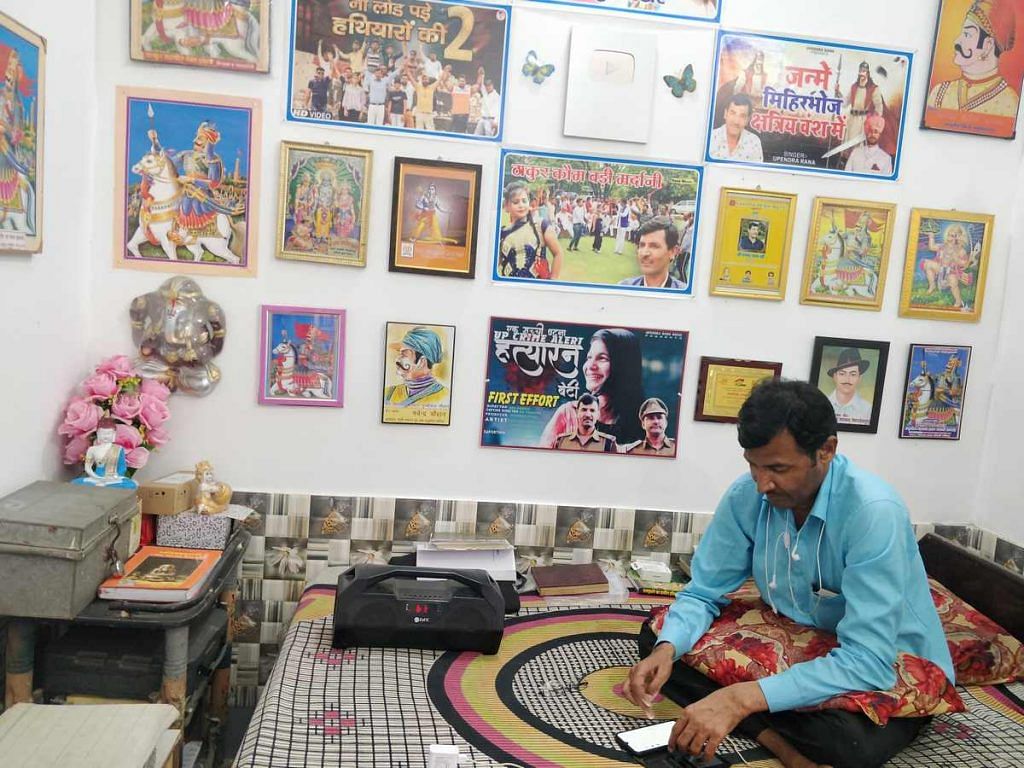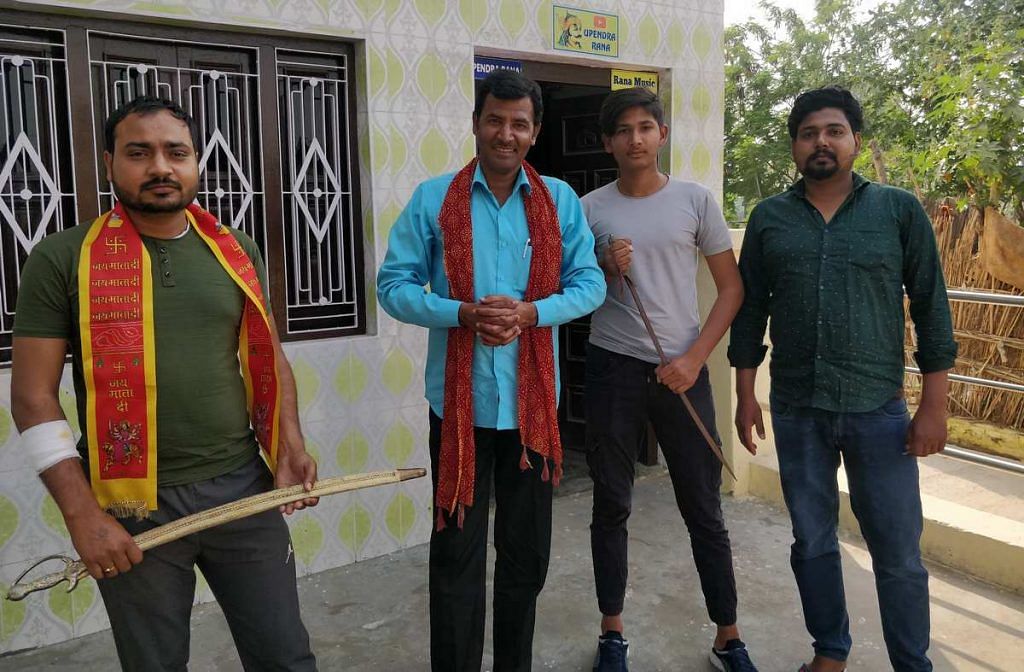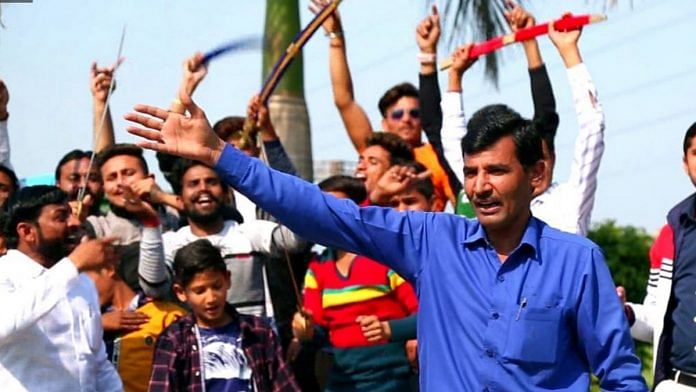Dadri: Months before religious leader Yati Narsinghanand took to the podium in Haridwar and called for arms to be raised against Muslims, he featured in a popular music video that pretty much had the same message, but relayed in the autotune-enhanced vocals of Uttar Pradesh’s Rajput-Hindutva pop sensation Upendra Rana.
The video, which has more than 1.5 lakh views on YouTube, was made with Narsinghanand’s approval, Rana tells ThePrint at his home in Rasulpur village in western UP’s Dadri block, 15 kilometres from Dasna where the influential priest is based.
“I met him in his temple. He is like a mentor to me. When I told him I want to make a video on him, he gave me Rs 2,100 as his blessing,” Rana, a former folk singer, says.
Dressed in a simple white shirt with dark trousers, the middle-aged and modestly whiskered Rana has the demeanour of a friendly bank clerk in the video, except for the sword and gun he occasionally brandishes and the bloodthirsty lyrics he sings to an upbeat tune: “Dharm ke khaatir aage badh ke, ab hathiyaar uthao (For the sake of your faith, come forward and pick up your weapons).”
The song, ‘Narsinghanand Jagave’, was filmed at the Dasna Devi Temple in Ghaziabad, UP, where Yati Narsinghanand is the mahant (spiritual leader). It features the orange-robed seer himself, mostly seated in the background, as Rana praises him as the lone protector of Hindu dharma.
There may be nothing exceptional about the 44-year-old Rana’s appearance, but he has become an icon of sorts in this Thakur/Rajput-dominated belt, where his lyrics and piercing voice resonate profoundly.
In fact, he has pioneered a new genre of sorts: the “DJ Rajput song”. Often featuring dance beats, drone shots, guns, swords, motorbike stunts, and beefed-up men wearing tight T-shirts flexing their muscles on camera, Rana’s music videos aggressively promote the dominance of the Thakur/Rajput identity.
He sings about the glorious history of the warrior caste, modern-day Thakur victors like Yogi Adityanath, and calls to arms for those who have forgotten their heritage. Hindu pride often fits in with these subjects. While Yati Narsinghanand is not a Rajput, his ideology is a match for the values Rana believes in, the singer says.
In a socially and politically volatile region of the country, which has seen communal riots and lynching incidents in the past, his songs are adding fuel to the fire.
Also Read: Behind the ‘bigot’: How engineer Deependra became Dasna’s hate-spewing sadhu Yati Narsinghanand
A slow rise to local stardom
In the peak summer of 2019, Upendra Rana was preparing to shoot a video for a new song called ‘Hum Thakur Superstar’ in a nearby village. He needed a few men to stand behind him as extras and asked one of the boys from his loosely held crew to call his friends. The word spread and more than 250 men gathered.
“They all wanted to be in the video. I asked the cameraman to zoom out and take all of them in the shot. These men have a kind of blind faith in me,” Rana says.

But this popularity came to him after years of struggle and fighting taboo within his home, he explains.
When he was 14 years old, Rana was influenced by the local Ragini (a folk subgenre) singers who would perform in his village. He started taking private lessons from them and after he was married at the age of 21, he dropped out of college to build his career in music.
Irregular village-level stage performances, however, were unsustainable financially and he took up a contractor job at an NTPC (National Thermal Power Corporation) plant, which was set up close to his home.
In 2007, he managed to recorded his first music cassette with a local label and almost a decade later he tied-up with a music company which had a YouTube channel. This was a game-changer. His songs, which drew references from history, were widely shared and by 2019, he decided to branch out with his own channel called ‘Upendra Rana’.

A lukewarm response to the first song he uploaded brought feedback from his younger audience, mostly Thakur boys around his village, who asked him to introduce a new-age groove to his music.
“Most of my fans are younger than me. They told me that nobody listens to folk music anymore. They wanted DJ beats,” says Rana, who calls himself a descendent of Maharaja Rana Pratap.
The formula worked. With its synth loops and Bhangra influences, Rana’s next song, ‘Thakur Kaum Badi Mardani’ crossed 50 lakh views.
It was as if he had cracked a secret code to success. His lyrics, generally based on the theme of Thakur supremacy, now had mass appeal with the upgraded music.
He was unstoppable. The songs poured in one after another, most crossing lakhs of views. ‘Hum Thakur Superstar’ broke all his previous records with 220 lakh views.
“His songs are played everywhere. Even if there is a devotional function, first pooja songs are played, then Upendra Rana’s,” Rinku Rana, a fan of Rana’s who lives in his village, says.
Rana’s rising popularity, however, was not happening in a vacuum.
Tapping into ‘Thakur power’
Western UP has for long been troubled by communal tension, but two major incidents under the Samajwadi Party rule in the state — the Muzaffarnagar riots in 2013 and the 2015 lynching of Mohammed Akhlaq — brought fissures between caste and religious groups in the region to the surface.
Most of the 18 men arrested in Akhlaq’s killing were Thakurs, and the prevailing sentiment in Dadri was that they were the real victims in this case and the state machinery had failed to protect them.
“The police arrested boys from this region and beat them up badly,” alleged Rinku Rana, a resident of Rasulpur village.
In 2017, then, when the BJP’s Yogi Adityanath, a Thakur, became Chief Minister, it was a new dawn for the likes of Rana. It had been almost two decades since someone from the caste had helmed the state (the last Rajput CM was Rajnath Singh, from 2000-2002), and the Thakur identity received a boost.
Rana’s songs, too, became more aggressive and reflected the might of the Thakurs, as well as the fear that this standing could be taken away if the right kind of machismo wasn’t demonstrated.

The imagery of guns, swords, and muscle, along with vocal exhortations to be at the ready with weapons, has given a sense of empowerment to the intended audience — Thakur youth in the hinterlands who are either employed or underemployed and thus at a general disadvantage except for their caste and heritage.
When there are few jobs and the only thing that comes cheap is phone data, catchy songs about reclaiming a glorious past and vanquishing a fictitious ‘enemy’ offer some measure of solace and strength, however misguided.
“Hindutva has changed in the common sense. People have a sense of history and it reaches more popularity through music. Joining it with performance makes it more attractive for the people,” Badri Narayan, professor and director at the G.B. Pant Social Science Institute and the author of several books on politics, says.
Rana has been an obvious beneficiary of this socio-political dynamic. The same music that once got him pitying glances has now made him a local celebrity and has allowed him to actually monetise his YouTube channel. The first time Rana earned from his music channel was in January 2020, he says, when he made a neat Rs 28,000.
He is now invited as a guest and speaker at functions organised by fringe Hindu and Thakur organisations. His Instagram photos show his neck swathed in marigold garlands, with eager fans posing next to him for photographs.
He has also been appointed as the pradesh upadhyaksh (state vice-president) of the Akhil Bharatiya Kshatriya Mahasabha, an organisation that advocates for the rights of the Rajput community.
‘I correct history through my songs’
Before Rana tasted success on YouTube, he would often participate in events organised by the Rashtravadi Pratap Sena, which calls itself a social organisation for the protection of Hindus. This outfit, formed in 2015, was accused of instigating the lynching of Akhlaq due to suspicions he had consumed beef.
“I brought Rana to the Sena. He used to do live performances for us,” Veer Singh Shishodia, Gautam Buddh Nagar’s district in-charge of the outfit, says. “After the 2015 incident, his popularity increased.”
Rana acknowledges that he would perform in the organisation’s events and help “collect a crowd” but that his contributions ended there.
In any case, the Akhlaq lynching is a fading memory and Rana has now taken his ‘warrior’ instincts to the cultural battleground. Whenever there is a hint that rival communities, like the Gujjars (also spelled as Gurjar) and Ahirs, are getting a little ahead of themselves, he steps in with bombastic songs to rouse public emotion.
“The Gujjars have gained economically by selling their land for development, but they have no social wealth. To enhance their stature, they associate themselves with us Kshatriyas. It has become a trend,” Rana says.
When Gujjars and Rajputs tussled about which community to which the 9th-century king Mihir Bhoj ‘belonged’, Rana was in the thick of the action.
The controversy broke out when, at a college in Dadri, Yogi Adityanath unveiled a statue of the said royal with a plaque that described him as “Gurjar Pratihar Samrat Mihir Bhoj’. The writing on the statue was changed to remove the word ‘Gurjar’ but Rana did not let matters end there. He released a song about how Mihir Bhoj was born into a Kshatriya clan and the learned men were not speaking about this injustice.
“I correct history through my songs. India has seen Muslim education ministers who have removed names of our kings. That is why I bring them in my songs,” he says, visibly agitated by what he sees as attempts by so-called inferior caste groups to appropriate Kshatriya glory.
The fight, of course, goes both ways.
On 1 January, Rana released a song on the valour of Rajput fighter Porus. A week later a group of men from the Ahir caste filed a complaint at the Gautam Buddh Nagar District Magistrate office demanding the song be taken off Rana’s YouTube channel.
At this time, Rana says, the entire Thakur community rallied behind him.
“This case against me was like a test to see who all will stand with me when there is a need. The entire Kshatriya society came out in my support. Even two elected representatives called me and asked if I need their help,” Rana says, pulling out two history books that suggest Porus was indeed a Rajput. He showed these books to the police as well, he adds proudly, and the inquiry against him sputtered out.
This urgent need to glorify the Rajput past, Dilip Mandal, former journalist and author, says, is because this caste has been a loser in the process of modernity.
“Unlike Brahmins, Vaishyas and other dominant castes which have negotiated well with the new era of knowledge economy, Thakurs have not seen that transformation. Brahmins have global CEOs, Baniyas have the economic might, but Thakurs have nothing. Their past is the only glory they have… the present is not that glorious for the community,” Mandal explains.
“In order to reclaim that glory and position, the voice gets more and more shrill, more and more aggressive.”
A war cry to a DJ beat
Rana’s “shrill and aggressive” call for action and unity has earned him not just fans, but would-be foot soldiers who credit him for their “awakening”.
“Upendra bhaiya‘s songs have united the Rajput samaj (community). His songs have brought this awareness of our past in us… Earlier the Rajput samaj was not aware,” Rinku Rana says, and his friends agree.
The dream for Rana and his supporters is not just Rajput-friendly wording in plaques or history books, but a Hindu Rashtra where Kshatriya warriors rise and vanquish “jihadi” enemies — never mind that they might be hard pressed to find a modern-day Akbar or Aurangzeb to test their mettle.
If there is one figure in whom these fantasies coalesce, it is Yogi Adityanath, who is set to embark upon his second term as Uttar Pradesh Chief Minister’s after the BJP’s landslide victory in the state.
Rana says he doesn’t write songs about politicians, but Yogi is an exception. On 11 March, a day after the BJP was declared winner in the UP assembly elections, Rana uploaded a song on the Thakur leader which set a new milestone in his YouTube metrics. Within 24 hours of the release of the song, it had two lakh views. His past record was 40,000.
“Yogi has shown that only Thakurs can rule,” Rana says proudly.
A bureaucrat who Rana did not wish to name has offered to take him to Lucknow for Adityanath’s swearing-in ceremony, he adds. “I asked him if Yogiji has watched my video. The meeting will be more fulfilling if he has. He will be able to recognise me.”
(Edited by Asavari Singh)
Also Read: Neha Singh Rathore: How ‘not-so-confident’ poet began singing truth to power with Bhojpuri rap






